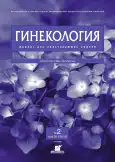Vol 20, No 2 (2018)
- Year: 2018
- Published: 15.04.2018
- Articles: 17
- URL: https://gynecology.orscience.ru/2079-5831/issue/view/1706
Full Issue
Articles
Postpartum contraception: efficacy and safety
Abstract
 5-8
5-8


Efficacy and safety of drospirenone-containing microdosage combined oral contraceptive use with starting contraception
Abstract
 9-13
9-13


Etiological structure and diagnosis of abnormal uterine bleeding
Abstract
 14-17
14-17


Opportunities for prevention and correction of genitourinary menopausal syndrome
Abstract
 18-22
18-22


 23-27
23-27


Efficacy of intrauterine administration of autologous peripheral blood mononuclear cells prior to embryo transfer in patients with recurrent implantation failures in assisted reproductive technology programmes
Abstract
 28-33
28-33


Effect of smoking on the development of placental lesions
Abstract
 34-40
34-40


Diagnosis and management patients with cervical insufficiency
Abstract
 41-45
41-45


Modern tocolysis and adverse effects of tocolytics
Abstract
 46-50
46-50


Purpose of the study. Evaluate the prognostic value of an independent and medical fence of the vaginal discharge for the HPV test
Abstract
 51-54
51-54


Modern approach to treatment of a recurrent bacterial vaginosis at women of the reproductive period
Abstract
Bacterial vaginosis is closely associated with increase in frequency of inflammatory diseases of woman's pelvis organs, infertility, spontaneous abortions, preterm labor, contaminating fetus, postnatal inflammatory complications and cervical neoplasia. Goal of the study was to improve treatment of relapsed bacterial vaginosis in women of reproductive age and asses the efficacy of the pathogenetic combination therapy. Materials and methods. In our research we observed 40 female patients, at the age of 18-35 years who were revealed relapsed bacterial vaginosis according to clinical and laboratory examination. We studied their anamnesis, clinical manifistation, microscopic examination of cervical discharge to detect bacterial vaginosis. Also we carried out polymerase chain reaction to identify conditionally pathogenic microbes (Femoflor-16) and pH-metry of vagina contents with colpotest. Results. Our research revealed increased quantity or lack of a normal microflora (Lactobacillus spp.) in all patients. Streptococcus spp. 45.00%; Staphylococcus spp. 40.00%; Atopobium vaginae 80.00%; Gardnerella vaginalis + Prevotella bivia Porphyromonas (titer>106) 70.00% were identified. Combination therapy allows to restore a vaginal ecosystem and prevents bacterial vaginosis relapse over period of 12 months in our patients. Conclusion. Polymerase chain reaction in real time (Femoflor-16) with vaginal pH-metry are the basic laboratory examination methods to confirm bacterial vaginosis. Use of a combination therapy allows to restore a vaginal ecosystem and prevents bacterial vaginosis relapse over period of 12 months in our patients.
 55-58
55-58


Topical issues in combined oral contraceptives usage
Abstract
 60-63
60-63


 64-66
64-66


Modern aspects of tactics in the genital herpes viral infection (literature review)
Abstract
 67-73
67-73


Bemiparin sodium in prevention of tromboembolic complications in gynecological practices
Abstract
 74-76
74-76


Reproductive disorders and obstetric complications in gynecological diseases
Abstract
This publication examines the existing risks of obstetric complications and other reproductive disorders in women with gynecological diseases. The paper also discusses the issues of the pre-school training of women with gynecological diseases, with special emphasis on the use of dipyridamole, due to its pleiotropic action.
 77-81
77-81


Review of the book of academician V.I.Krasnopolsky “Obligate forms of precancerous and invasive cervical cancer”
 82-82
82-82












